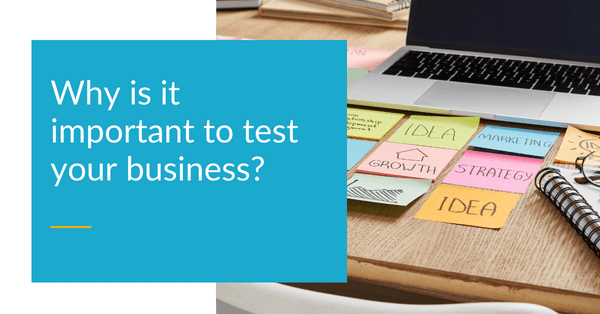Testing a business idea. Have you had an idea for a business? Or maybe you are at the stage where you are thinking of starting a business? If your answer to both of these questions is yes, then you must be wondering about how to validate this business idea. Validating your business idea is the first and most important step. Here are some steps to follow in order to test and validate your business idea.
Why is it important to test your business
According to the British Business Bank, many start-up businesses fail because their idea wasn’t good enough to capture customers’ imaginations and get them to buy. Too often, new business owners sink their savings into an idea that isn’t viable, leaving them facing financial challenges when their start-up fails.

You should test your business idea to:
- Understand the market – what type of customers would buy from your business, where they are located and what problem will your business solve for them.
- Set pricing – learn how much to charge and how much customers are willing to pay.
- Refine processes – if you’re making a product or shipping to customers, trialing ideas can identify manufacturing, supply, and delivery issues before launch.
- Attract investment – testing your business idea involves researching the market and understanding costs, pricing, volumes, and margins. These are all vital for a business plan designed to attract investment.
- Tweak your offering – testing prevents you from getting so close to your business that you can’t see the flaws. Honest feedback means you can tweak your product or service to better meet customer needs
Understand Your Target Audience
One of the key steps in testing a business idea is identifying and understanding your target audience.
Your target audience consists of the people who are most likely to be interested in and benefit from your product or service. By understanding their preferences, needs, and pain points, you can tailor your concept to meet their specific requirements.
Start by conducting market research to gather information about your target audience.
This can include demographic data, psychographic information, and insights into their purchasing behavior. You can use a variety of research methods, such as surveys, interviews, and focus groups, to gather this information.
Once you have a clear understanding of your target audience, you can use this information to refine your business concept.
Consider how your product or service can solve their problems or fulfill their needs better than existing solutions. This will help you create a compelling value proposition that resonates with your target audience.
Have a minimum viable project!

As we have talked about in our previous blog, developing a minimum viable product (MVP) is a crucial component of the lean startup model, providing an effective approach to business development and product creation before launching in the market.
An MVP represents the simplest form of your idea that can be sold as a product, as explained by Eric Ries, an entrepreneur based in Silicon Valley and the author of The Lean Startup.
The lean startup model encourages entrepreneurs to build an MVP, which serves as a simplified version of their idea that can be sold as a product. This allows for early testing, market validation, and iterative improvements based on real feedback, resulting in a more refined and customer-oriented final product.
Conduct market research
The next step to testing a business idea is conducting market research. As we discussed in our previous blog, it’s important to take some time away from the keyboard and reflect on what it is that you’re going to be doing.
You most likely have already come up with an idea for your online business. However, if you’re still in need of inspiration, your first step should be to try looking for a need.
Ask family, friends, peers, and forums whether there are any services, products, or content that they’d love to be able to access on the internet, but haven’t been able to find.
Similarly, you should think about your own experiences. Has there ever been a time when you’d searched for something online, but hadn’t come across a good enough result?
Before committing to investing time and money into your idea, you’ll want to know that it’s got the potential to be successful.
Analyzing and interpreting the results

Based on the insights gained from the analysis of the results, it’s time to make necessary adjustments and iterations to your business concept.
Use the feedback and data gathered to identify areas for improvement and prioritize the changes that will have the most significant impact on your concept’s performance.
Iterate on your MVP and incorporate the necessary changes based on the feedback received.
This may involve refining your product or service features, adjusting your pricing strategy, or improving your marketing messaging.
Continuously test and gather feedback as you make these adjustments to ensure that you are moving in the right direction.
Talk to your customers
The next step in testing a business idea is talking to your customers and getting feedback from them. In that way you can truly understand the depth of the problems that the customer is facing. We talked about this in detail in on of our previous blogs.
There are many ways that you can talk to your customers to get feedback. Here are a few that you can do right away:

1. Create a survey:
Google Survey has a free option where you can create a survey with questions to ask your customers directly. What you want to do is consider contacting 20 – 50 people in the niche personally and asking them some questions to thoroughly understand their situation and what problems they face, as well as what desires they have.
2. Conduct customer interviews:
The startup approach to entrepreneurship is based on a simple idea: quickly find out what works and discard the rest. That way you’ll discover if your idea is worth pursuing before putting a lot of time and effort into it. One of the key ways that entrepreneurs uncover what works is through customer interviews to discover critical information such as: What do the customers really need? Does your business idea meet that need?
3. Meet them in person:
You can even meet them in person for coffee or lunch, or ask them what problems and desires they have. Sometimes, there’s no better way than to get offline and out of your head and go talk to somebody in person.
Contemplate your idea
Although you’re excited about your new business idea, it is best you wait a while before fleshing out a potential company.
After you’ve gone through the process of writing down a bunch of ideas, you should wait a couple of days to see which ideas really stick the best.
It is advisable to only move forward with the idea that excites you the most and that you feel that it would work best.
After completing the necessary preparatory steps, the most effective approach to testing a business idea is to develop a prototype and seek genuine feedback by showcasing it to people. This enables you to gather honest and authentic insights that can guide further improvements and refinements.
Building a prototype allows you to present a tangible representation of your idea, giving potential customers and stakeholders the opportunity to interact with and evaluate its features and functionalities. By observing their reactions and collecting their feedback, you gain valuable insights into the strengths, weaknesses, and potential areas of enhancement for your business concept.
The Importance of Continuous Testing and Iteration

Testing a business idea before launch is important, but it’s also important to continue testing and iterating after launch. By gathering feedback from customers and analyzing data about your product or service’s performance, you can identify areas for improvement and make changes to better meet your target audience’s needs.
Continuous testing and iteration can help you stay ahead of the competition, improve your product or service, and ultimately drive business growth. It’s important to make testing and iteration a part of your ongoing business strategy.
Conclusion
So, there you have it, a basic guide to testing your business idea, including several specific examples of how you can test your idea with just a little bit of work. As you can see, testing your idea doesn’t have to be a long, drawn-out process that takes months or years. It doesn’t even take much money. All it takes is a little bit of work on your end, a little bit of time, and of course, a little bit of patience. Don’t be afraid to fail, because failing is the only way to truly learn. We hope this article has given you some useful information to take the next step in testing your business idea.
If you have any questions about business idea testing, please ask us anytime by filling out this form here.
Before you go, I want to offer you something. It is a 3-month coaching/done-for-you service hybrid program designed to help you create multiple streams of traffic, significantly reduce your content creation time, and increase your passive revenue possibilities without the overwhelm and confusion.
SEO content writing not only helps you create high-quality, keyword-focused content that ranks well in search engines and generates organic traffic to your website, but it also helps you convert that traffic into leads and sales.
With Your Own SEO Content Machine Working For You 24/7, You Can Spend Less Time Marketing & Launching — And More Time Doing What You Love.
You can read more about it here.






0 Comments